-

新人教版高中英语选修2Unit 3 Reading for writing教学设计
The theme of this part is to write an article about healthy diet. Through reading and writing activities, students can accumulate knowledge about healthy diet, deepen their understanding of the theme of healthy diet, and reflect on their own eating habits. This text describes the basic principles of healthy diet. The author uses data analysis, definition, comparison, examples and other methods. It also provides a demonstration of the use of conjunctions, which provides important information reference for students to complete the next collaborative task, writing skills, vivid language materials and expressions.1. Teach Ss to learn and skillfully use the new words learned from the text.2. Develop students’ ability to understand, extract and summarize information.3. Guide students to understand the theme of healthy diet and reflect on their own eating habits.4. To guide students to analyze and understand the reading discourse from the aspects of theme content, writing structure, language expression, etc., 5. Enable Ss to write in combination with relevant topics and opinions, and to talk about their eating habits.1. Guide students to analyze and understand the reading discourse from the aspects of theme content, writing structure, language expression, etc.2. Enable them to write in combination with relevant topics and opinions, and to talk about their eating habits.3. Guide the students to use the cohesive words correctly, strengthen the textual cohesion, and make the expression fluent and the thinking clear.Step1: Warming upbrainstorm some healthy eating habits.1.Eat slowly.2.Don’t eat too much fat or sugar.3.Eat healthy food.4.Have a balanced diet.Step2: Read the passage and then sum up the main idea of each paragraph.

新人教版高中英语选修2Unit 2 Reading for writing教学设计
The theme of this section is to express people's views on studying abroad. With the continuous development of Chinese economic construction, especially the general improvement of people's living standards, the number of Chinese students studying abroad at their own expense is on the rise. Many students and parents turn their attention to the world and regard studying abroad as an effective way to improve their quality, broaden their horizons and master the world's advanced scientific knowledge, which is very important for the fever of going abroad. Studying abroad is also an important decision made by a family for their children. Therefore, it is of great social significance to discuss this issue. The theme of this section is the column discussion in the newspaper: the advantages and disadvantages of studying abroad. The discourse is about two parents' contribution letters on this issue. They respectively express their own positions. One thinks that the disadvantages outweigh the advantages, and the other thinks that the advantages outweigh the disadvantages. The two parents' arguments are well founded and logical. It is worth noting that the two authors do not express their views on studying abroad from an individual point of view, but from a national or even global point of view. These two articles have the characteristics of both letters and argumentative essays1.Guide the students to read these two articles, and understand the author's point of view and argument ideas2.Help the students to summarize the structure and writing methods of argumentative writing, and guides students to correctly understand the advantages and disadvantages of studying abroad3.Cultivate students' ability to analyze problems objectively, comprehensively and deeply

新人教版高中英语选修2Unit 2 Using langauge-Listening教学设计
? B: Absolutely! Getting involved with Chinese cultural activities there definitely helped a lot. I got to practice my Chinese on a daily basis, and I could learn how native Chinese speakers spoke.? A: What do you feel is your biggest achievement?? B: Learning Chinese characters! I have learnt about 1,500 so far. When I first started, I didn't think it was even going to be possible to learn so many, but now I find that I can read signs, menus, and even some easy newspaper articles.? A: What are you most keen on?? B: I've really become keen on learning more about the Chinese culture, in particular Chinese calligraphy. As I have learnt Chinese characters, I have developed a great appreciation for their meaning. I want to explore Chinese characters by learning how to write them in a more beautiful way. ? A: Finally, what do you want to say to anyone interested in learning Chinese?? I have really become keen on learning more about the Chinese culture, in particular Chinese Calligraphy. As I have learnt Chinese character, I have developed a great appreciation for their meaning. I want to explore Chinese characters by learning how to write them in a more beautiful way.? A: Finally, what do you want to say to anyone interested in learning Chinese?? B: I'd say, give it a shot! While some aspects may be difficult, it is quite rewarding and you will be happy that you tried.? A: Thanks for your time. ? B:You're welcome.

新人教版高中英语选修2Unit 3 Using langauge-Listening教学设计
1. How is Hunan cuisine somewhat different from Sichuan cuisine?The heat in Sichuan cuisine comes from chilies and Sichuan peppercorns. Human cuisine is often hotter and the heat comes from just chilies.2.What are the reasons why Hunan people like spicy food?Because they are a bold people. But many Chinese people think that hot food helps them overcome the effects of rainy or wet weather.3.Why do so many people love steamed fish head covered with chilies?People love it because the meat is quite tender and there are very few small bones.4.Why does Tingting recommend bridge tofu instead of dry pot duck with golden buns?Because bridge tofu has a lighter taste.5 .Why is red braised pork the most famous dish?Because Chairman Mao was from Hunan, and this was his favorite food.Step 5: Instruct students to make a short presentation to the class about your choice. Use the example and useful phrases below to help them.? In groups of three, discuss what types of restaurant you would like to take a foreign visitor to, and why. Then take turns role-playing taking your foreign guest to the restaurant you have chosen. One of you should act as the foreign guest, one as the Chinese host, and one as the waiter or waitress. You may start like this:? EXAMPLE? A: I really love spicy food, so what dish would you recommend?? B: I suggest Mapo tofu.? A: Really ? what's that?

新人教版高中英语选修2Unit 4 Learning about Language教学设计
This section guides students to pay attention to the typical context of vocabulary use, helps students accumulate vocabulary around the key vocabulary of this unit, and uses the learned words and word chunks in different contexts to deeply understand their meaning and usage, so as to achieve the purpose of review and consolidation.The teaching design activities aim to guide students to pay attention to the typical context in which the target vocabulary is used, as well as the common vocabulary used in collocation, so that students can complete the sentence with correct words. In terms of vocabulary learning strategies, this unit focuses on cultivating students' ability to pay attention to collocation of words and to use word blocks to express meaning.For vocabulary learning, it is not enough just to know the meaning of a single word, but the most important thing is to master the common collocations of words, namely word blocks.Teachers should timely guide students to summarize common vocabulary collocation, such as verb and noun collocation, verb and preposition collocation, preposition and noun collocation, and so on.1. Guide students to understand and consolidate the meaning and usage of the vocabulary in the context, 2. Guide the students to use the unit topic vocabulary in a richer context3. Let the students sort out and accumulate the accumulated vocabulary, establishes the semantic connection between the vocabulary,4. Enable students to understand and master the vocabulary more effectivelyGuiding the Ss to use unit topic words and the sentence patterns in a richer context.

新人教版高中英语选修2Unit 4 Reading for writing教学设计
假定你是英国的Jack,打算来中国旅行,请你给你的中国笔友李华写一封信,要点如下:1.你的旅行计划:北京→泰山→杭州;2.征求建议并询问他是否愿意充当你的导游。注意:1.词数80左右(开头和结尾已给出,不计入总词数);2.可以适当增加细节,以使行文连贯。参考词汇:故宫 the Forbidden City;泰山 Mount TaiDear Li Hua,I'm glad to tell you that 'm going to visit China.First,I am planning to visit Beijing,the capitalof China,where I am looking forward to enjoying the Great Wall,the Forbidden City and somebeautiful parks.Then I intend to go to visit Mount Tai in Shandong Province.I've heard that it is one ofthe most famous mountains in China and I can't wait to enjoy the amazing sunrise there.After that,I amalso going to Hangzhou.It is said that it is a beautiful modern city with breathtaking natural sights,among which the West Lake is a well- known tourist attraction.What do you think of my travel plan? Will you act as my guide? Hope to hear from you soon.

新人教版高中英语选修2Unit 4 Using langauge-Listening教学设计
The theme of the listening section is " talking about scenery and culture along a journey."The part is designed to further lead the students to understand Canadian natural geography and social environment, and integrated into the cultural contrast by mentioning the long train journey from Beijing to Moscow routes. On this basis, the part activates students related travel experience, lets the student serial dialogue, guides the student to explore further the pleasure and meaning of the long journey, and Chinese and foreign cultural comparison.The part also provides a framework for the continuation of the dialogue, which is designed to provide a framework for students to successfully complete their oral expressions, and to incorporate an important trading strategy to end the dialogue naturally.1. Help students to understand and master some common English idioms in the context, and experience the expression effect of English idioms.2. Guide the students to understand the identity of different people in the listening context, and finish the dialogue according to their own experience.3. Instruct the students to use appropriate language to express surprise and curiosity about space and place in the dialogue, and master the oral strategy of ending the dialogue naturally.1. Instruct students to grasp the key information and important details of the dialogue.2. Instruct students to conduct a similar talk on the relevant topic.

新人教版高中英语选修2Unit 5 Learning about Language教学设计
The purpose of this section of vocabulary exercises is to consolidate the key words in the first part of the reading text, let the students write the words according to the English definition, and focus on the detection of the meaning and spelling of the new words. The teaching design includes use English definition to explain words, which is conducive to improving students' interest in vocabulary learning, cultivating their sense of English language and thinking in English, and making students willing to use this method to better grasp the meaning of words, expand their vocabulary, and improve their ability of vocabulary application. Besides, the design offers more context including sentences and short passage for students to practice words flexibly.1. Guide students to understand and consolidate the meaning and usage of the vocabulary in the context, 2. Guide the students to use the unit topic vocabulary in a richer context3. Let the students sort out and accumulate the accumulated vocabulary, establishes the semantic connection between the vocabulary,4. Enable students to understand and master the vocabulary more effectivelyGuiding the Ss to use unit topic words and the sentence patterns in a richer context.Step1: Read the passage about chemical burns and fill in the blanks with the correct forms of the words in the box.

新人教版高中英语选修2Unit 5 Reading and thinking教学设计
The theme of this activity is to learn the first aid knowledge of burns. Burns is common in life, but there are some misunderstandings in manual treatment. This activity provides students with correct first aid methods, so as not to take them for granted in an emergency. This section guides students to analyze the causes of scald and help students avoid such things. From the perspective of text structure and collaborative features, the text is expository. Expository, with explanation as the main way of expression, transmits knowledge and information to readers by analyzing concepts and elaborating examples. This text arranges the information in logical order, clearly presents three parts of the content through the subtitle, accurately describes the causes, types, characteristics and first aid measures of burns, and some paragraphs use topic sentences to summarize the main idea, and the level is very clear.1. Guide students to understand the causes, types, characteristics and first aid methods of burns, through reading2. Enhance students’ ability to deal withburnss and their awareness of burns prevention3. Enable students to improve the ability to judge the types of texts accurately and to master the characteristics and writing techniques of expository texts.Guide students to understand the causes, types, characteristics and first aid methods of burns, through readingStep1: Lead in by discussing the related topic:1. What first-aid techniques do you know of ?CPR; mouth to mouth artificial respiration; the Heimlich Manoeuvre

新人教版高中英语选修2Unit 5 Using langauge-Listening教学设计
The theme of this section is to learn how to make emergency calls. Students should learn how to make emergency calls not only in China, but also in foreign countries in English, so that they can be prepared for future situations outside the home.The emergency telephone number is a vital hotline, which should be the most clear, rapid and effective communication with the acute operator.This section helps students to understand the emergency calls in some countries and the precautions for making emergency calls. Through the study of this section, students can accumulate common expressions and sentence patterns in this context. 1.Help students accumulate emergency telephone numbers in different countries and learn more about first aid2.Guide the students to understand the contents and instructions of the telephone, grasp the characteristics of the emergency telephone and the requirements of the emergency telephone.3.Guide students to understand the first aid instructions of the operators.4.Enable Ss to make simulated emergency calls with their partners in the language they have learned1. Instruct students to grasp the key information and important details of the dialogue.2. Instruct students to conduct a similar talk on the relevant topic.Step1:Look and discuss:Match the pictures below to the medical emergencies, and then discuss the questions in groups.
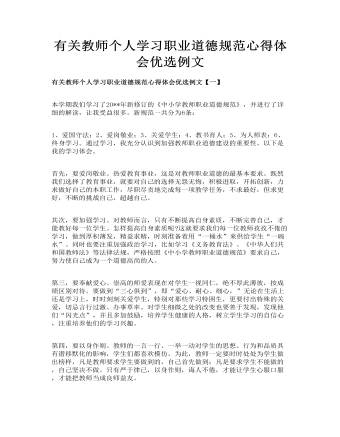
有关教师个人学习职业道德规范心得体会优选例文
第三,要奉献爱心。崇高的师爱表现在对学生一视同仁,绝不厚此薄彼,按成绩区别对待。要做到“三心俱到”,即“爱心、耐心、细心,”无论在生活上还是学习上,时时刻刻关爱学生,特别对那些学习特困生,更要付出特殊的关爱,切忌言行过激、办事草率。对学生细微之处的改变也要善于发现,发现他们“闪光点”,并且多加鼓励,培养学生健康的人格,树立学生学习的自信心,注重培养他们的学习兴趣。 第四,要以身作则。教师的一言一行、一举一动对学生的思想、行为和品质具有潜移默化的影响,学生们都喜欢模仿。为此,教师一定要时时处处为学生做出榜样,凡是教师要求学生要做到的,自己首先做到;凡是要求学生不能做的,自己坚决不做。只有严于律已,以身作则,诲人不倦,才能让学生心服口服,才能把教师当成良师益友。
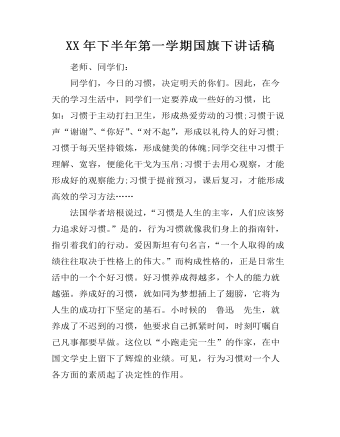
XX年下半年第一学期国旗下讲话稿
老师、同学们:同学们,今日的习惯,决定明天的你们。因此,在今天的学习生活中,同学们一定要养成一些好的习惯,比如:习惯于主动打扫卫生,形成热爱劳动的习惯;习惯于说声“谢谢”、“你好”、“对不起”,形成以礼待人的好习惯;习惯于每天坚持锻炼,形成健美的体魄;同学交往中习惯于理解、宽容,便能化干戈为玉帛;习惯于去用心观察,才能形成好的观察能力;习惯于提前预习,课后复习,才能形成高效的学习方法……法国学者培根说过,“习惯是人生的主宰,人们应该努力追求好习惯。”是的,行为习惯就像我们身上的指南针,指引着我们的行动。爱因斯坦有句名言,“一个人取得的成绩往往取决于性格上的伟大。”而构成性格的,正是日常生活中的一个个好习惯。好习惯养成得越多,个人的能力就越强。养成好的习惯,就如同为梦想插上了翅膀,它将为人生的成功打下坚定的基石。小时候的 鲁迅 先生,就养成了不迟到的习惯,他要求自己抓紧时间,时刻叮嘱自己凡事都要早做。这位以“小跑走完一生”的作家,在中国文学史上留下了辉煌的业绩。可见,行为习惯对一个人各方面的素质起了决定性的作用。
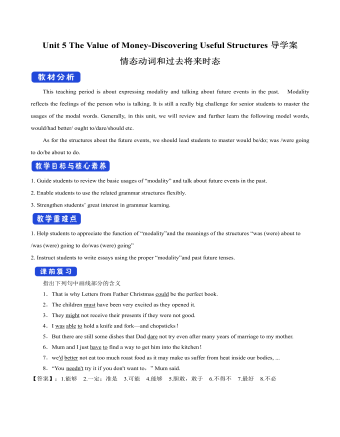
新人教版高中英语必修3Unit 5 The Value of Money-Discovering Useful Structures导学案
4.They were going to find someone to take part in their bet when they saw Henry walking on the street outside.[归纳]1.过去将来时的基本构成和用法过去将来时由“would+动词原形”构成,主要表示从过去某一时间来看将要发生的动作(尤其用于宾语从句中),还可以表示过去的动作习惯或倾向。Jeff knew he would be tired the next day.He promised that he would not open the letter until 2 o'clock.She said that she wouldn't do that again.2.表示过去将来时的其他表达法(1)was/were going to+动词原形:该结构有两个主要用法,一是表示过去的打算,二是表示在过去看来有迹象表明将要发生某事。I thought it was going to rain.(2)was/were to+动词原形:主要表示过去按计划或安排要做的事情。She said she was to get married next month.(3)was/were about to+动词原形:表示在过去看来即将要发生的动作,由于本身已含有“即将”的意味,所以不再与表示具体的将来时间状语连用。I was about to go to bed when the phone rang.(4)was/were+现在分词:表示在过去看来即将发生的动作,通常可用于该结构中的动词是come,go,leave,arrive,begin,start,stop,close,open,die,join,borrow,buy等瞬间动词。Jack said he was leaving tomorrow.
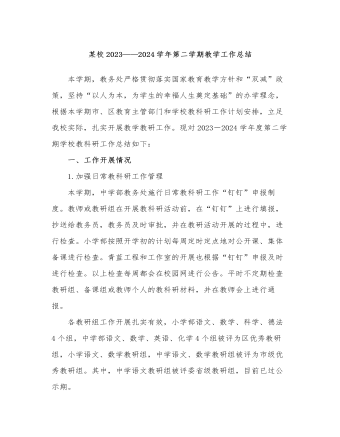
某校2023——2024学年第二学期教学工作总结
开学初,为充分发挥各功能室的作用,音乐、美术、科学、物理、化学教研组拟定各功能室的使用安排,教务处不定期抽查功能室使用情况。同时各功能室建立规范的使用记录、活动记录、损坏维修、报损等记录,实验室有实验教学计划、实验进度安排及分组(演示)实验通知单,分组实验报告单,图书室有借阅和阅览记录等原始记录。8.规范学籍管理严格按上级文件要求进行学籍管理,特别是省外学生的转入转出,规范学籍转入、转出、休学、复学等工作。另外,学校作为XX教育集团领头羊,还成功承办了多项区级、教育集团活动,成绩显著。二、待提升的工作1.校本课程因各类特殊原因,本学期校本课程尚未开足开齐,部分外聘教师的课程教学效果有待提高,下学期将提前谋划,精准落实。
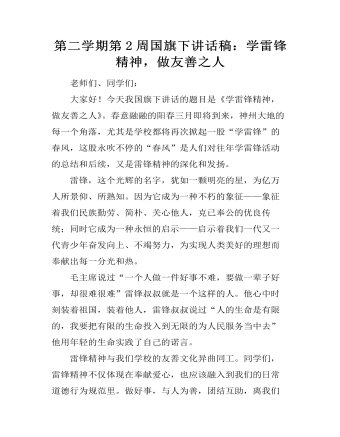
第二学期第2周国旗下讲话稿:学雷锋精神,做友善之人
老师们、同学们:大家好!今天我国旗下讲话的题目是《学雷锋精神,做友善之人》。春意融融的阳春三月即将到来,神州大地的每一个角落,尤其是学校都将再次掀起一股“学雷锋”的春风,这股永吹不停的“春风”是人们对往年学雷锋活动的总结和后续,又是雷锋精神的深化和发扬。雷锋,这个光辉的名字,犹如一颗明亮的星,为亿万人所景仰、所熟知。因为它成为一种不朽的象征——象征着我们民族勤劳、简朴、关心他人,克已奉公的优良传统;同时它成为一种永恒的启示——启示着我们一代又一代青少年奋发向上、不竭努力,为实现人类美好的理想而奉献出每一分光和热。毛主席说过“一个人做一件好事不难,要做一辈子好事,却很难很难”雷锋叔叔就是一个这样的人。他心中时刻装着祖国,装着他人,雷锋叔叔说过“人的生命是有限的,我要把有限的生命投入到无限的为人民服务当中去”他用年轻的生命实践了自己的诺言。

关于大学生三下乡支教教育个人心得体会八篇
我也是农村长大的孩子,在农村的日子就是我整个童年,虽然没有城市的繁荣和物质基础,但在农村我就是一只自由自在、欢乐无比的小鸟。走进白石小学,我仿佛又回到了我那个自由洒脱的童年。孩子们的欢声笑语,孩子们的调皮捣蛋,还有孩子们的聪明伶俐,无不让我感到开心和幸福。这种幸福感不像是亲人朋友给予的爱,而是把你带进你无法回到的过去的难忘时光。在我们安排的课程中,里面大多数是以第二课堂为主。为了吸引孩子们的注意和培养他们的兴趣,我们也是使出浑身解数,让课程变得有趣而不乏味。虽然经历了当老师的辛苦,但孩子们带给我们的欢乐和感动让我们觉得一切都值得。在我所参与的课堂中,我看到了“老师们”的窘迫,但孩子们却还是学得很认真笑得很开心。这就是我们现在无法相比的,孩子们的天真热情,单纯可爱,让我们这些最初不抱好想法的大学生感到温暖,很快,我们就融入其中了。
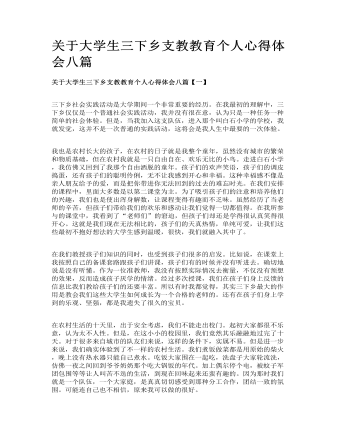
关于大学生三下乡支教教育个人心得体会八篇
在我们教授孩子们知识的同时,也受到孩子们很多的启发。比如说,在课堂上我按照自己的备课套路跟孩子们讲课,孩子们有的时候并没有听进去。确切地说是没有听懂。作为一位准教师,我没有按照实际情况去衡量,不仅没有预想的效果,反而造成孩子厌学的情绪。经过多次授课,我们在孩子们身上反馈的信息比我们教给孩子们的还要丰富。所以有时我都觉得,其实三下乡最大的作用是教会我们这些大学生如何成长为一个合格的老师的。还有在孩子们身上学到的乐观、坚强,都是我遗失了很久的宝贝。
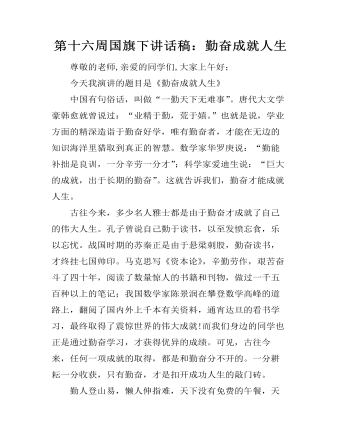
第十六周国旗下讲话稿:勤奋成就人生
尊敬的老师,亲爱的同学们,大家上午好;今天我演讲的题目是《勤奋成就人生》中国有句俗话,叫做“一勤天下无难事”。唐代大文学豪韩愈就曾说过:“业精于勤,荒于嬉。”也就是说,学业方面的精深造诣于勤奋好学,唯有勤奋者,才能在无边的知识海洋里猎取到真正的智慧。数学家华罗庚说:“勤能补拙是良训,一分辛劳一分才”;科学家爱迪生说:“巨大的成就,出于长期的勤奋”。这就告诉我们,勤奋才能成就人生。古往今来,多少名人雅士都是由于勤奋才成就了自己的伟大人生。孔子曾说自己勤于读书,以至发愤忘食,乐以忘忧。战国时期的苏秦正是由于悬梁刺股,勤奋读书,才终挂七国帅印。马克思写《资本论》,辛勤劳作,艰苦奋斗了四十年,阅读了数量惊人的书籍和刊物,做过一千五百种以上的笔记;我国数学家陈景润在攀登数学高峰的道路上,翻阅了国内外上千本有关资料,通宵达旦的看书学习,最终取得了震惊世界的伟大成就!而我们身边的同学也正是通过勤奋学习,才获得优异的成绩。可见,古往今来,任何一项成就的取得,都是和勤奋分不开的。一分耕耘一分收获,只有勤奋,才是扣开成功人生的敲门砖。
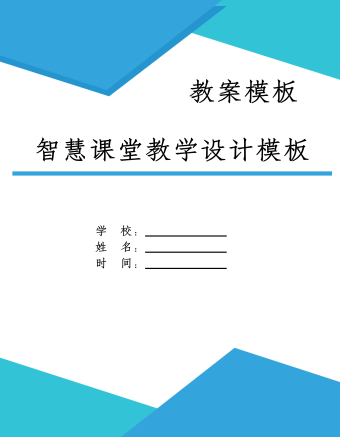
分式方程的解法及应用教学设计与学案
内容:分式方程的解法及应用——初三中考数学第一轮复习学习目标:1、熟练利用去分母化分式方程为整式方程2、熟练利用分式方程的解法解决含参数的分式方程的问题重点:分式方程的解法(尤其要理解“验”的重要性)难点:含参数的分式方程问题预习内容:1、观看《分式方程的解法》《含参数分式方程增根问题》《解含参分式方程》视频2、完成预习检测

开学典礼领导个人发言讲话稿例文精选
同学们,人生就像一条奔腾不息的河流,有平静舒缓的静水深流,也有波涛汹涌的激流飞瀑,但无论如何这条生命之河都不会逆向流淌。大学作为其中的一段,亦是如此。面对这人生当中仅有一次的宝贵经历,任何一个人都没有理由不去珍视它。认识到这一点,我们就会更加明晰“我的人生”和“我的大学的责任。诗人歌德曾经说过:责任就是对自己要求去做的事情有一种爱。这就是说,做一个有责任的人近乎成了人的一种本能。因为爱我们的祖国,所以我们自然就有了“国家兴亡匹夫有责”的报国热情;因为爱我们的父母,所以我们自然就懂得了“谁言寸草心报得三春晖”的感恩之情;因为爱知识,所以我们从不缺少“路漫漫其修远兮,吾将上下而求索”的求知热情。责任,一个看似空泛的概念,实则充实而厚重。


